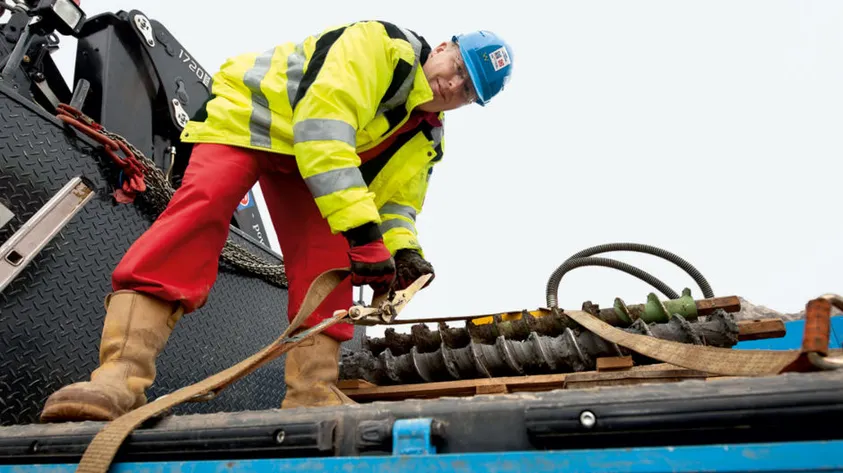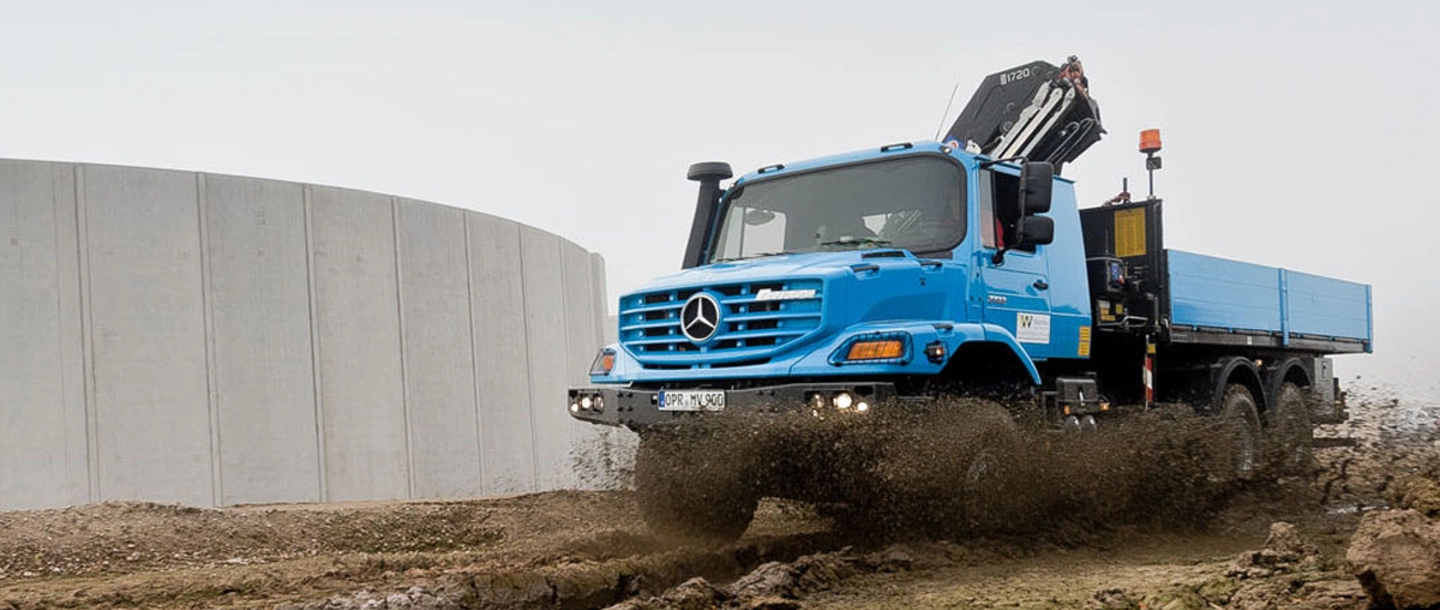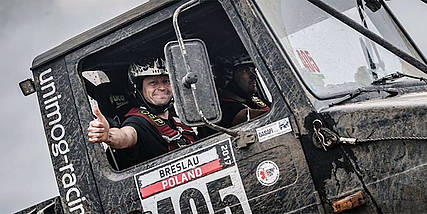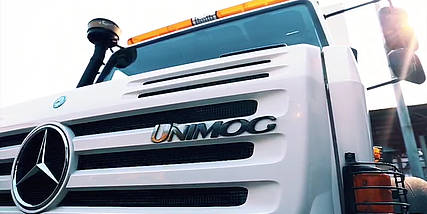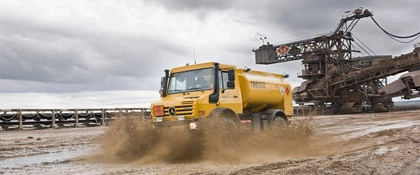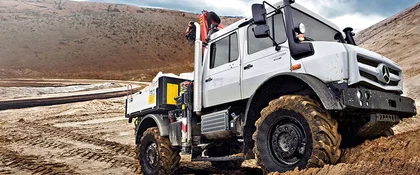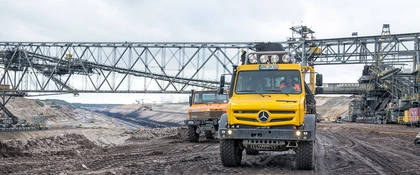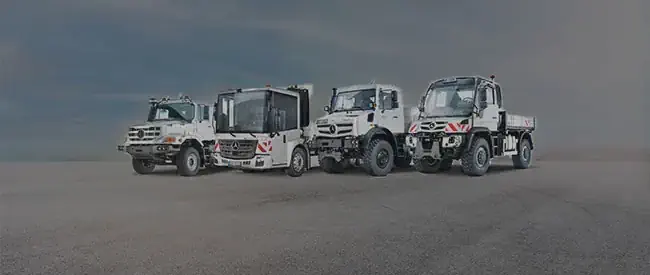“Our job is to lower the groundwater level so that the civil engineers can work efficiently and safety,” says Beckemeier. To ensure this, wells are drilled, pumps are attached and pipelines are laid. With its 36 employees, Wasserbau Wusterhausen GmbH is in operation throughout Germany. Only recently, Beckemeier operated the Zetros in Dortmund and Gütersloh. “Long distances are no problem whatsoever. The level of ride comfort is high and we are relaxed when we reach our work location.”
With a whirr, Enrico Klein extends the vehicle’s lateral supports via remote control. The Zetros shakes when it hits the support plates and presses them into the ground. A display behind the cab lights up, showing 100 per cent. “We operate almost exclusively in tough terrain. The mud is often knee-high. The vehicle must stand securely, otherwise we are unable to work,” says Klein. Job safety has top priority. The crane, which can lift 1.4 tonnes at an outreach of ten metres, is remote controlled. This means that the crane operators are always outside of the danger zone.
The body of the Zetros 2733 comes from Hüffermann Transportsysteme. It is configured to meet the specific requirements of Wasserbau Wusterhausen. There is space on the vehicle’s loading area for six vacuum piston pumps, each one weighing 1.6 tonnes. With the additional drill piping, the payload of ten tonnes leaves a comfortable reserve. “We used to operate the Unimog for drilling and the Actros for the material. Now, we save two to three trips. The material for a construction pit can be completely transported by the Zetros, with pumps, filters and everything else that’s needed,” says Klein.
The decision to buy the versatile heavyweight was taken by Meinhard van Rüschen, the managing director of Wasserbau Wusterhausen GmbH. He was convinced that the Zetros was the right vehicle when he saw it in photos shown to him by his salesperson Torsten Liebig from Autohaus Jürgens in Neuruppin. “The first thing I thought was: That vehicle is yelling for hard work on tough terrain,” the man born in Cloppenburg recalls. “I think exactly the same thing today.”
The first thing I thought was: That vehicle is yelling for hard work on tough terrain.
Meinhard van Rüschen, managing director Wasserbau Wusterhausen GmbH
Van Rüschen grasped the opportunity to personally drive the vehicle when it was collected from the plant in Wörth in spring. “Seeing it in our blue company livery for the first time was a special moment. It does an excellent job and also motivates my employees. They reckon it’s brilliant – and my customers do too.” He is now negotiating the purchase of a two-axle Zetros.
Enrico Klein stands a few metres away from the vehicle with both legs firmly in the clay and operates the crane via remote control. He sets down a pump hovering in the air a short distance from the Zetros. The crane can rotate through 360 degrees. Because the Zetros is flat, work can be carried out in front of and behind the vehicle. And drilling can be done on both sides, which is a particularly important aspect for the hydraulic engineers. “The outreach is twice as extensive as it used to be,” says Klein. “We no longer have to reposition the vehicle as often as we used to, we get a lot more work done and we are also more flexible.”
Transporting pumps and wastewater piping is the core business of the company from Wusterhausen. Four of these pumps are in operation on the site, day and night, seven days a week. Each one has a capacity of up to 90,000 litres of water per hour. Pipelines channel it into a ditch, from where it flows into the River Elbe.
Almost immediately after the pump has been set down, Klein and Beckemeier attach a rotating drilling unit to the crane. The drilling rod is fixed to this. Klein had previously marked the drilling point with a spray can, and that’s exactly where the drilling will begin. “It’s going in well,” says Beckemeier, satisfied at how the auger slowly winds its way into the ground. The bore diameter is only 120 millimetres and the drilling depth is up to seven metres. First of all, the ground is dark and clay-like, then becomes more grey, more sandy and more damp. Dozens of small wells are spread out across the entire terrain. Klein kneels down above the borehole and lowers a light contact gauge. At a depth of 2.30 metres, it reaches groundwater and starts to light up. A clear indication of the nearby River Elbe, which explains the dampness of the ground.
Klein and Beckemeier dismantle the rods, clean them and put them back on the loading area. They retract the crane and the supports. The Zetros is ready to drive again. Enrico Klein steps into the cab, which is positioned behind the front axle on a cab-behind-engine vehicle. This gives the vehicle its characteristic silhouette and makes it manageable on tough terrain. If the cab were positioned on the axle, as in a vehicle with front-wheel steering, driving would be like a rodeo ride for the driver. Klein takes up a comfortable position on the air suspension driver seat, starts up the 7.2-litre diesel engine, and moves the Zetros 50 metres. There are still a whole lot of holes to be drilled before the return journey to Wusterhausen.
